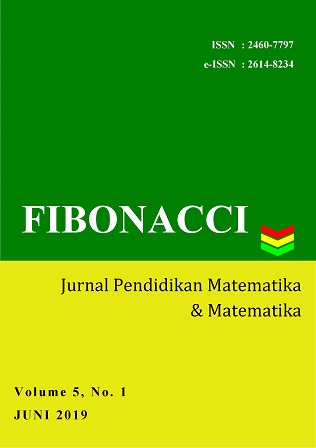ETNOMATEMATIKA: EKSPLORASI DALAM TARIAN TRADISIONAL PADA PEMBUKAAN ASIAN GAMES 2018
Main Article Content
Abstract
Article Details
Authors who publish with this journal agree to the following terms:
- Authors retain copyright and grant the journal right of first publication with the work simultaneously licensed under a Creative Commons Attribution License that allows others to share the work with an acknowledgement of the work's authorship and initial publication in this journal.
- Authors are able to enter into separate, additional contractual arrangements for the non-exclusive distribution of the journal's published version of the work (e.g., post it to an institutional repository or publish it in a book), with an acknowledgement of its initial publication in this journal.
- Authors are permitted and encouraged to post their work online (e.g., in institutional repositories or on their website) prior to and during the submission process, as it can lead to productive exchanges, as well as earlier and greater citation of published work (See The Effect of Open Access).
References
Abdullah, A. S. 2017. “Ethnomathematics in perspective of sundanese culture”. Journal on Mathematics Education, Vol. 8 (1), pp: 1-16.
Alunaza SD, H. A. R. D. I. 2014. Analisa Diplomasi Budaya Indonesia Melalui Tari Saman Gayo dalam Mengukuhkan Identitas Nasional Bangsa (Doctoral dissertation, University of Muhammadiyah Malang).
Arisetyawan, A., Suryadi, D., Herman, T., Rahmat, C., dan No, J. D. S. 2014. “Study of Ethnomathematics: A lesson from the Baduy Culture”. International Journal of Education and Research, Vol. 2 (10), pp: 681-688.
Dahlan, J. A., Permatasari, R. 2018. “Pengembangan Bahan Ajar Berbasis Etnomatematika dalam Pembelajaran Matematika Sekolah Menengah Pertama”. JNPM (Jurnal Nasional Pendidikan Matematika) Vol. 2 (1), pp: 133-150.
Haryanto, et. all. 2017. “Ethnomathematics arfak (West Papua-Indonesia: Numeracy of Arfak”. International Journal of Scientific & Technology Research, Vol. 6 (9), pp: 325-327.
Kusuma, D. A., et al. 2016. “The role of ethnomathematics in West Java (A preliminary analysis of case study in Cipatujah)”. Journal of Physics: Conf. Series 893.
Maryati & Prahmana, R.C.I. 2018. “Ethnomathematics: Exploring the Activities of Designing Kebaya Kartini”. MaPan: Jurnal Matematika dan Pembelajaran, Vol. 6 (1), pp: 11-19.
Prahmana, R. C. I. 2017. Design research (Teori dan implementasinya: Suatu pengantar). Jakarta: Rajawali Pers.
Purnamasari, M., Isman, J., Damayanti, A., dan Ismah, I. 2017. “Upaya Meningkatkan Hasil Belajar Matematika terhadap Konsep Bangun Ruang Materi Luas dan Volume Balok dan Kubus Menggunakan Metode Drill Sekolah SMP Islam Al-Ghazali Kelas VIII”. Fibonacci: Jurnal Pendidikan Matematika dan Matematika, Vol. 3 (1), pp: 45-52.
Putri, L. I. 2017. “Eksplorasi etnomatematika kesenian rebana sebagai sumber belajar matematika pada jenjang MI”. Jurnal Pendas, Vol. 4(1).
Rahmadiana, N. S. 2017. Nilai Etika Dan Estetika Tari Ratoeh Jaroe pada Masyarakat Aceh di Kota Langsa (Doctoral dissertation, UNIMED).
Risdiyanti, I., dan Prahmana, R. C. I. 2018. “Etnomatematika: Eksplorasi dalam Permainan Tradisional Jawa”. Journal of Medives: Journal of Mathematics Education IKIP Veteran Semarang, Vol. 2 (1), pp: 1-11.
Rohayati, S., Karno, K., dan Chomariyah, W. I. 2017. Identifikasi Etnomatematika pada Masjid Agung di Yogyakarta.
Rosa, M. dan Orey, D. C. 2011. “Ethnomathematics: the cultural aspects of mathematics”. Revista Latinoamericana de Etnomatemática, Vol. 4 (2). pp: 32-54.
Sinambela, P. N. 2017. “Kurikulum 2013 dan Implementasinya dalam Pembelajaran”. Generasi Kampus, Vol. 6(2).
Siregar, N. 2017. Relevansi Nilai-Nilai Tari Saman Terhadap Pendidikan Karakter dalam Pembelajaran IPS. Disertasi dan Tesis Program Pascasarjana UM.
Sudirman, S., Rosyadi, R., dan Lestari, W. D. 2017. “Penggunaan Etnomatematika pada Karya Seni Batik Indramayu dalam Pembelajaran Geometri Transformasi”. Journal of Mathematics Education, Vol. 2 (1).
Vasquez, E. L. 2017. “Ethnomathematics as an Epistemological Booster for investigating Culture and Pedagogical Experience with the Young Offender or Prison School Communities”. Journal of Education and Human Development, Vol. 6 (2), pp: 117-127.

